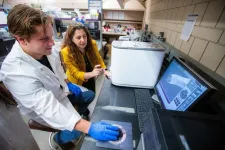(Press-News.org) A new catalog produced by a French-led international team of astronomers shows that NASA’s Fermi Gamma-ray Space Telescope has discovered 294 gamma-ray-emitting pulsars, while another 34 suspects await confirmation. This is 27 times the number known before the mission launched in 2008.
“Pulsars touch on a wide range of astrophysics research, from cosmic rays and stellar evolution to the search for gravitational waves and dark matter,” said study coordinator David Smith, research director at the Bordeaux Astrophysics Laboratory in Gironde, France, which is part of CNRS (the French National Center for Scientific Research). “This new catalog compiles full information on all known gamma-ray pulsars in an effort to promote new avenues of exploration.”
The catalog was published on Monday, Nov. 27, in The Astrophysical Journal Supplement.
Pulsars are a type of neutron star, the city-sized leftover of a massive sun that has exploded as a supernova. Neutron stars, containing more mass than our Sun in a ball less than 17 miles wide, represent the densest matter astronomers can study directly. They possess strong magnetic fields, produce streams of energetic particles, and spin quickly – 716 times a second for the fastest known. Pulsars, in addition, emit narrow beams of energy that swing lighthouse-like through space as the objects rotate. When one of these beams sweeps past Earth, astronomers detect a pulse of emission.
The new catalog represents the work of 170 scientists across the globe. A dozen radio telescopes carry out regular monitoring of thousands of pulsars, and radio astronomers search for new pulsars within gamma-ray sources discovered by Fermi. Other researchers have teased out gamma-ray pulsars that have no radio counterparts through millions of hours of computer calculation, a process called a blind search.
Of the 3,400 pulsars known, most of them observed via radio waves and located within our Milky Way galaxy, only about 10% also pulse in gamma rays, the highest-energy form of light. Visible light has energies between 2 and 3 electron volts. Fermi’s Large Area Telescope can detect gamma rays with billions of times this energy, and other facilities have observed emission thousands of times greater still from the nearby Vela pulsar, the brightest persistent source in the sky for Fermi.
The Vela pulsar and its famous sibling in the Crab Nebula are young, solitary objects, formed about 11,000 and 970 years ago, respectively. Their emissions arise as their magnetic fields spin through space, but this also gradually slows their rotation. The younger Crab pulsar spins nearly 30 times a second, while Vela clocks in about a third as fast.
The Old and the Restless
Paradoxically, though, pulsars that are thousands of times older spin much faster. One example of these so-called millisecond pulsars (MSPs) is J1824-2452A. It whirls around 328 times a second and, with an age of about 30 million years, ranks among the youngest MSPs known.
Thanks to a great combination of gamma-ray brightness and smooth spin slowdown, the MSP J1231-1411 is an ideal “timer” for use in gravitational wave searches. By monitoring a collection of stable MSPs, astronomers hope to link timing changes to passing low-frequency gravitational waves – ripples in space-time – that cannot be detected by current gravitational observatories. It was discovered in one of the first radio searches targeting Fermi gamma-ray sources not associated with any known counterpart at other wavelengths, a technique that turned out to be exceptionally successful.
"Before Fermi, we didn't know if MSPs would be visible at high energies, but it turns out they mostly radiate in gamma rays and now make up fully half of our catalog," said co-author Lucas Guillemot, an associate astronomer at the Laboratory of Physics and Chemistry of the Environment and Space and the University of Orleans, France.
Along Come the Spiders
The presence of MSPs in binary systems offers a clue to understanding the age-spin paradox. Left to itself, a pulsar’s emissions slow it down, and with slower spin its emissions dim. But if closely paired with a normal star, the pulsar can pull a stream of matter from its companion that, over time, can spin up the pulsar.
“Spider” systems offer a glimpse of what happens next. They’re classified as redbacks or black widows – named for spiders known for consuming their mates. Black widows have light companions (less than about 5% of the Sun's mass), while redbacks have heavier partners. As the pulsar spins up, its emissions and particle outflows become so invigorated that – through processes still poorly understood – it heats and slowly evaporates its companion. The most energetic spiders may fully evaporate their partners, leaving only an isolated MSP behind.
J1555-2908 is a black widow with a surprise – its gravitational web may have ensnared a passing planet. An analysis of 12 years of Fermi data reveals long-term spin variations much larger than those seen in other MSPs. “We think a model incorporating the planet as a third body in a wide orbit around the pulsar and its companion describes the changes a little better than other explanations, but we need a few more years of Fermi observations to confirm it,” said co-author Colin Clark, a research group leader at the Max Planck Institute for Gravitational Physics in Hannover, Germany.
Other curious binaries include the so-called transitional pulsars, such as J1023+0038, the first identified. An erratic stream of gas flowing from the companion to the neutron star may surge, suddenly forming a disk around the pulsar that can persist for years. The disk shines brightly in optical light, X-rays, and gamma rays, but pulses become undetectable. When the disk again vanishes, so does the high-energy light and the pulses return.
Some pulsars don’t require a partner to switch things up. J2021+4026, a young, isolated pulsar located about 4,900 light-years away, underwent a puzzling “mode change” in 2011, dimming its gamma rays over about a week and then, years later, slowly returning to its original brightness. Similar behavior had been seen in some radio pulsars, but this was a first in gamma rays. Astronomers suspect the event may have been triggered by crustal cracks that temporarily changed the pulsar‘s magnetic field.
Farther afield, Fermi discovered the first gamma-ray pulsar in another galaxy, the neighboring Large Magellanic Cloud, in 2015. And in 2021, astronomers announced the discovery of a giant gamma-ray flare from a different type of neutron star (called a magnetar) located in the Sculptor galaxy, about 11.4 million light-years away.
“More than 15 years after its launch, Fermi remains an incredible discovery machine, and pulsars and their neutron star kin are leading the way,” said Elizabeth Hays, the mission’s project scientist at NASA’s Goddard Space Flight Center in Greenbelt, Maryland.
END
NASA’s Fermi Mission nets 300 gamma-ray pulsars … and counting
2023-11-28
ELSE PRESS RELEASES FROM THIS DATE:
Study reveals hidden immune defense against cancer
2023-11-28
FINDINGS
Researchers at the UCLA Jonsson Comprehensive Cancer Center have found certain immune cells can still fight cancer even when the cancer cells lack an important protein that the immune system relies on to help track down cancer cells.
The team discovered the absence of the crucial protein B2M seems to activate an alternative immune response involving natural killer (NK) cells and CD4+ T cells in both animal studies and patient tumor biopsies, indicating a potential backup mechanism in the immune system to recognize and attack cancer cells.
BACKGROUND
Immunotherapies, such as immune ...
Annals of Family Medicine: papers explore how technology is changing medical practice and how doctors are adapting
2023-11-28
Providence, R.I. – From the ability to conduct clinical visits online to utilizing artificial intelligence to effectively diagnose patients, technology has changed how all doctors practice medicine. One published paper in the November/December issue of Annals of Family Medicine explains how AI-driven technology presents new opportunities for more effective patient care while a second paper describes the interplay between fulfillment of basic psychological needs at work and technology use in maintaining clinician well-being.
In ...
Researchers advance 'placenta-on-a-chip' with sensing, imaging technology
2023-11-28
AMES, Iowa – A research poster dated Dec. 9, 2015, hangs just outside Nicole Hashemi’s Iowa State University laboratory. It introduces a major project for Hashemi and her research group. And it’s evidence that scientific persistence sometimes equals scientific advancement.
Hashemi, an associate professor of mechanical engineering, and her students have been working all these years to develop a “placenta-on-a-chip.” In this case that’s a thin, rectangular, clear, polymer block with two tiny microchannels – just millionths of ...
How neurotransmitters work together to detect and discriminate odors
2023-11-28
A longstanding hypothesis in neurobiology was that a single neuron releases a single type of neurotransmitter, a molecule used by neurons to communicate with one another. In recent decades, several neurons have been found to release more than one neurotransmitter. This phenomenon called co-transmission is increasingly gaining recognition as a powerful and versatile molecular mechanism useful for the dynamic regulation of diverse neural circuits. However, precisely how co-transmission affects the firing of ...
ChargeX Consortium recommends common EV charging station error codes
2023-11-28
New shared language will facilitate faster service, improve EV user experience
The National Charging Experience Consortium (ChargeX) has released a report that recommends 26 common electric vehicle (EV) charging error codes to enable faster error reporting, diagnostics and resolution within the EV charging industry. Ultimately, the codes would improve the U.S. charging experience.
The ChargeX Consortium is a collaboration between U.S. Department of Energy national laboratories, EV charging industry experts, consumer advocates and other stakeholders.
The Recommendations for Minimum Required Error Codes report aims to reduce confusion between charger manufacturers, EV manufacturers and ...
Ending the HIV epidemic may require addressing “everyday” discrimination
2023-11-28
Latino sexual minority men who experience racial, ethnic and sexual prejudice are more likely to delay HIV testing, complicating efforts to end the more than 40-year epidemic, according to a new Rutgers study.
“Total HIV infection rates in the United States are stabilizing, which is good news,” said Gabriel Robles, an assistant professor at the Rutgers School of Social Work and coauthor of the paper published in the journal AIDS Education and Prevention. “What’s bad is that the trend for some subgroups, including some Latino/x sexual minority men, is going in the opposite direction. Our study offers ...
Anonymous $10 million gift to Henry Ford Health establishes lung cancer tissue repository, bolsters research
2023-11-28
As Lung Cancer Awareness Month comes to a close, Henry Ford Health is proud to announce it has received an anonymous gift of $10 million, which is poised to significantly advance lung cancer research at Henry Ford Cancer.
This transformative gift has enabled Henry Ford to establish a new lung cancer tissue biorepository, which is a facility that catalogs and stores biological samples for research. These samples – in this case, lung cancer tissue – are crucial for scientists who are studying ...
RCSI researchers develop material that reduces bacterial infection and speeds up bone healing
2023-11-28
28 November 2023: Researchers at RCSI University of Medicine and Health Sciences and Advanced Materials and Bioengineering Research Centre (AMBER) have developed a new surgical implant that has the potential to transform the treatment of complex bone infections. When implanted on an injured or infected bone, the material can not only speed up bone healing, it also reduces the risk of infections without the need for traditional antibiotics.
The newly published paper in the journal Advanced Materials, tackles the complex clinical problem of bone infection, ...
Contrast sensitivity of ON and OFF human retinal pathways in myopia
2023-11-28
Across the entire animal kingdom, visual images are processed by two major neuronal pathways that extract light and dark stimuli from visual scenes – ON (light on) and OFF (light off) pathways.
Light stimuli are brighter than their background like a white cloud in a gray sky whereas dark stimuli are darker than the background like a black bird in a blue sky. The two pathways can extract stimuli with different contrasts but some pathways are more sensitive than others. In carnivores and rodents, ON pathways are more sensitive ...
DFW air quality continues to miss EPA goals for safety
2023-11-28
Air quality in the Dallas-Fort Worth metropolitan area continues to miss safety levels set by the Environmental Protection Agency (EPA) and is unlikely to meet EPA goals anytime soon, according to new research from The University of Texas at Arlington.
Purnendu “Sandy” Dasgupta, professor of chemistry and biochemistry and the Hamish Small Chair of Ion Analysis at The University of Texas at Arlington, said the region’s low population density, lack of widespread public transportation and reliance on cars contribute to its poor air quality. Its ozone values have exceeded safety levels set by the EPA for the last 20 years.
“Compared ...




